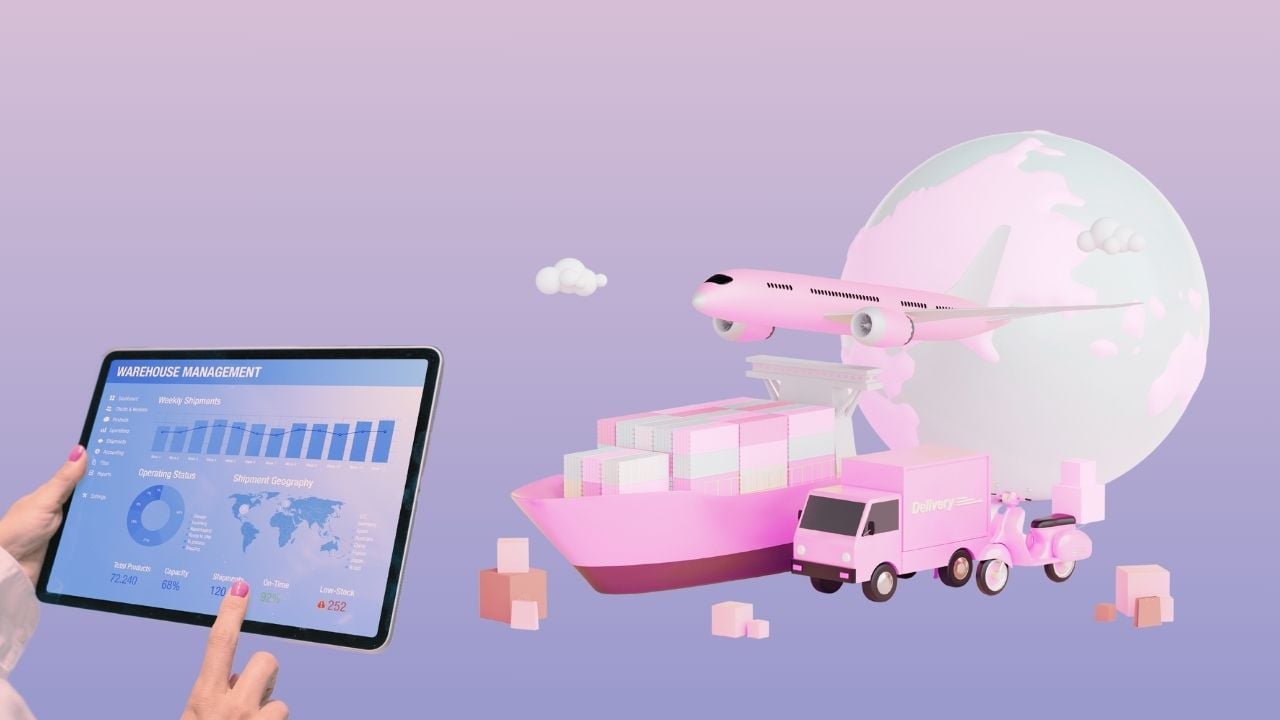Discover the ERP vs WMS: A Comprehensive Guide for 3PLs and Brands
- Introduction
- What is an ERP?
- Inventory and ERPs: How do they work together?
- What is a WMS?
- Inventory and WMS: How do they work together?
- What’s the difference between an ERP and a WMS?
- How does a modern WMS enhance ERPs?
- What WMS features extend beyond ERP capabilities?
- The ultimate question: WMS or ERP?
- How can Osa Commerce help?
Introduction
Supply chains are transforming, making the adoption of new technology essential for managing logistics innovations, rapid scaling, and revenue growth. A survey involving over 2,000 supply chain leaders revealed that 90% plan to invest more than $1 million annually in new technology, according to the 2023 MHI Annual Industry Report. Among these, 38% aim to spend between $10 to $100 million.
For third-party logistics (3PL) warehouses and retailers, the dilemma is whether to stick with existing systems like Enterprise Resource Planning (ERP) or to explore new alternative solutions. These decisions hinge on whether current systems can meet consumer demands, scale with the business, or support future growth strategies.
As the logistics landscape evolves, companies are faced with crucial investment decisions that ensure their success. Modern 3PLs or retailers managing inventory need more than a traditional Warehouse Management System (WMS); they require comprehensive solutions that integrate all business aspects, from procurement to delivery. Although many options exist, some technologies are more effective and compatible with the forthcoming supply chain landscape.
Next, we'll explore the differences between ERP and WMS technologies and why your business needs to adopt advanced and modern WMS solutions.
Table of Contents
- What is an ERP?
- Inventory and ERPs: How do they work together?
- What is a WMS?
- Inventory and WMS: How do they work together?
- What’s the difference between an ERP and a WMS?
- How does a modern WMS enhance ERPs?
- What WMS features extend beyond ERP capabilities?
- The ultimate question: WMS or ERP?
- How can Osa Commerce help?
What is an ERP?
An Enterprise Resource Planning (ERP) system is a comprehensive toolbox of business applications including functions for accounting, human resources, procurement, supply chain management, and customer relationship management. These systems act as centralized databases, gathering, storing, and analyzing data from various departments. By providing a holistic view of organizational activities, ERPs monitor performance, track resources, optimize workflows, and adapt to market changes. Customizable modules within ERPs facilitate communication and collaboration across departments, driving productivity and fostering business growth.
The core functionalities of an ERP typically include:
- Financial Management: Centralizes financial data and processes, including accounting, budgeting, and financial reporting for streamlined financial operations.
- Human Resources Management: Manages human resources operations, from payroll and benefits administration to recruiting, training, and performance management.
- Supply Chain Management: Streamlines supply chain processes, from procurement and order processing to logistics and distribution management.
- Inventory Management: Provides tools to track inventory levels, orders, sales, and deliveries.
- Customer Relationship Management (CRM): Integrates customer information and manages customer interactions, sales tracking, customer service, and marketing, enhancing customer satisfaction and retention.
- Procurement: Manages purchasing processes, including supplier management, purchase order processing, and contract management, ensuring products and services are procured at the best possible prices.
- Project Management: Supports planning, tracking, and managing all aspects of projects, including resources, budgets, and timelines, to ensure project delivery within scope, time, and budget.
- Manufacturing and Production Planning: Streamlines production processes by managing product planning, materials sourcing, production scheduling, and product forecasting.
- Business Intelligence: Provides analytical tools and reporting features to generate insights from business data.
- Compliance and Risk Management: Helps businesses adhere to legal, regulatory, and risk management guidelines, reducing potential legal and security issues.
Inventory and ERPs: How do they work together?
Traditionally, ERP systems have been vital for manufacturers and distributors in handling procurement, production scheduling, and inventory. With e-commerce and omnichannel fulfillment growing, some 3PLs now use ERPs to monitor inventory across various locations.
It's important to recognize that ERPs excel in inventory accounting rather than inventory management. Inventory accounting focuses on the financial tracking of inventory, such as valuation and cost accounting, for reporting purposes. In contrast, inventory management is about controlling stock levels and availability to meet customer demand, involving stock monitoring, replenishment, and warehouse organization.
In supply chain management, ERPs can manage inventory levels and financials, track fulfillment, and assist with financial reporting. While they cover many aspects of general inventory and accounting, achieving the operational focus of a Warehouse Management System (WMS) demands more of an effort. A WMS specifically optimizes warehouse and supply chain operations, improving processes like picking, packing, and shipping for better efficiency and accuracy. Hence, ERPs provide broad inventory and financial management across the supply chain, but WMSs offer more focused support for warehouse and supply chain operations.
-1.jpg?width=1280&height=720&name=Blog%20covers%20(6)-1.jpg)
Mastering Supply Chain: The Crucial Role of Inventory Forecast
What is a WMS?
A Warehouse Management System (WMS) is a sophisticated software solution that serves as the backbone and foundation of supply chain operations. Designed originally for third-party logistics (3PL) warehouses, many of today’s supply chain businesses including fourth-party logistics (4PL), brands, and retailers use WMS platforms to optimize and manage operations within a warehouse, from inventory management and picking processes to shipping and receiving. Its multifaceted functionalities extend beyond ERP systems and mere inventory tracking, encompassing a wide array of tasks essential for efficient warehouse and holistic supply chain operations.
The core functionalities of a WMS typically include:
- Inventory Management: Tracking the movement and storage of goods within the warehouse, including receiving, putaway, picking, packing, and shipping.
- Order Management: Managing the processing of customer orders, including order picking, order packing, and order shipping.
- Receiving: Receiving goods into the warehouse, verifying quantities, and updating inventory records.
- Putaway: Allocating storage locations for received goods based on predefined criteria such as item characteristics, storage capacity, and demand.
- Picking: Selecting items from their storage locations to fulfill customer orders or replenish picking locations, optimizing picking routes and methods for efficiency.
- Packing: Packaging items for shipment, including selecting appropriate packaging materials, labeling, and preparing documentation.
- Shipping: Arranging transportation for outbound shipments, generating shipping labels, and coordinating with carriers for pickup.
- Inventory Control: Ensuring accurate inventory counts through regular cycle counting, reconciliation, and adjustments.
- Warehouse Layout Optimization: Optimizing the layout of the warehouse to in order maximize space utilization, minimize travel distances, and improve workflow efficiency.
- Task Management: Assigning tasks to warehouse personnel, tracking task completion, and prioritizing tasks based on operational requirements.
- Labor Management: Tracking labor productivity, monitoring workforce performance, and optimizing labor utilization.
- Reporting and Analytics: Generating reports and analytics to track key performance indicators (KPIs), monitor warehouse performance, and identify areas for improvement.
In essence, a WMS acts as a strategic enabler, empowering 3PLs and their brand or retailer customers to achieve operational excellence, optimize resource utilization, and deliver superior customer experiences.
Inventory and WMS: How do they work together?
Warehouse Management Systems (WMS) and inventory management are closely intertwined within the logistics and supply chain processes. The core functionalities of a WMS are inclined to improve overall operations, inventory accuracy, optimize resource utilization, and enhance efficiency within the warehouse environment as a whole.
WMS features enhance inventory management by offering the following functionalities:
- Inventory Visibility: A WMS provides real-time visibility into inventory levels within the warehouse. It tracks the movement of goods and updates inventory counts as items are received, picked, packed, and shipped. This information is crucial for accurate inventory management.
- Inventory Accuracy: By utilizing barcode scanning, RFID technology, or other tracking methods, a WMS ensures that inventory records are accurate and up-to-date. This accuracy is essential for inventory management systems to make informed decisions about stock levels, reordering, and replenishment.
- Order Fulfillment: Inventory management systems rely on accurate data from the WMS to fulfill customer orders efficiently. When an order is received, the WMS identifies the location of the items within the warehouse, coordinates the picking process, and updates inventory levels in real-time as items are picked and packed.
- Replenishment: WMS systems can trigger replenishment alerts to inventory management systems when stock levels fall below predefined thresholds. This ensures that inventory is replenished promptly to prevent stockouts and maintain optimal inventory levels.
- Space Utilization: WMS systems optimize warehouse layout and storage configurations to maximize space utilization. This information is valuable for inventory management systems to allocate storage locations effectively and manage inventory flow within the warehouse.
- Reporting and Analytics: Both WMS and inventory management systems generate reports and analytics to track key performance indicators (KPIs) such as inventory turnover, stock accuracy, order fill rates, and warehouse productivity. This data helps businesses make informed decisions and continuously improve their operations.

Stronger Global Supply Chain: Insights, Technology, and Best Practices

You need more than a WMS!
What’s the difference between an ERP and a WMS?
When it comes to navigating the difficulties of supply chain management, understanding the key differences between an ERP system and a WMS is crucial.
An ERP (Enterprise Resource Planning) system is a comprehensive software platform that integrates various functions across an entire organization.
A WMS (Warehouse Management System), on the other hand, is focused specifically on optimizing warehouse and distribution center operations for increased efficiency.
While an ERP system offers a broad overview and management of a company's overall operations, a WMS provides detailed, specialized support for warehouse operations. In many cases, extending an ERP system to run warehouse operations can lead to a significant increase in total cost of ownership and lengthen the time to value—especially for 3PLs who require specific WMS functionality and features.
Enterprise Resource Planning System
Pros:
- Broad Solution: ERP covers many business processes, including procurement, inventory management, financials, and more.
- Resource Planning: It facilitates strategic decision-making by providing insights across various departments, aiding in resource allocation.
- Integrations: ERP integrates different business functions, enabling communication and data sharing between departments.
Cons:
- Limited Focus: While ERP may include some warehouse management features, they are often basic and not as robust as dedicated WMS solutions - especially for e-commerce and omnichannel businesses.
- Complexity and Maintenance: ERP systems can be complex and challenging to implement, requiring significant time and resources to maintain as the business changes.
- Cost: ERP implementations can be costly due to licensing fees, customization, and ongoing maintenance.
- Time to Value: ERP can take years to implement causing strain on current processes and holding patterns for company growth.
Warehouse Management System
Pros:
- Specialized Functionality: WMS is designed specifically for warehouse and e-commerce operations, offering advanced features for inventory tracking, order fulfillment, and storage optimization.
- Operational Efficiency: WMS software enhances operational efficiency within the warehouse and logistics partners by optimizing processes such as picking, packing, and shipping.
- Real-time Visibility: WMS provides real-time visibility into inventory levels, movements, and inventory forecasting, enabling better decision-making and preventing stockouts or overstock situations.
- Integrations: When choosing the best WMS, tech-agnostic API integrations will be imperative when connecting to partners, customers, and existing systems.
Cons:
- Scope: Some WMS solutions can focus solely on warehouse operations and may lack broader business functionalities present in ERP systems.
- Human Errors: Many processes with warehouse management systems can be automated. However for those that are not, human errors can cause inaccurate data.
- Financial Management: Modern WMS systems should have the ability to automate billing and invoices. However, many lack greater visibility into financial management.
ERP and WMS serve distinct purposes in supply chain management. Integrating both systems can provide comprehensive coverage from strategic planning to operational execution. ERP acts as the overarching system for business management, while WMS specializes in warehouse operations. Leveraging the strengths of both systems allows businesses to achieve seamless coordination, driving efficiency and profitability in the supply chain.
How does a modern WMS enhance ERPs?
As e-commerce and omnichannel supply chains continue to scale, many businesses find that they must choose between an ERP or WMS. While ERPs do offer some supply chain functionalities, extending an ERP to manage day-to-day warehouse operations and processes can lead to unnecessary costs and added complexities. Today’s 3PLs, 4PLs, and logistics businesses require a WMS to scale their options while also being able to integrate alongside an ERP system to bridge the gap and revolutionize operations.
Implementing a WMS is crucial for scaling a 3PL as it improves efficiency, scalability, inventory management, customer satisfaction, and overall operational optimization, enabling seamless growth and adaptation to changing market demands.
- Specialized Functionality: While ERPs offer broad functionality across multiple business functions, WMS systems provide specialized features tailored specifically for warehouse operations. This includes advanced inventory management, optimized processes, and real-time tracking of warehouse activities—all designed to minimize errors and ensure smooth operations.
- Improved Efficiency: WMS systems streamline warehouse operations, reducing manual tasks and automating processes such as order picking, packing, and shipping. This improves overall efficiency and reduces labor costs.
- Enhanced Inventory Visibility and Control: WMS software provides real-time visibility into inventory across multiple warehouses, locations, and vendors enabling 3PLs to efficiently manage inventory levels, track stock movements, and prevent stockouts or overstock situations. This is crucial to meet increasing demand while avoiding costly inventory management mistakes.
- Optimized Resource Utilization: WMS systems optimize the utility of warehouse resources, including space, equipment, and labor. By intelligently allocating resources based on demand, WMS systems maximize warehouse throughput and minimize idle time.
- Seamless Integration: Modern WMS systems seamlessly integrate with ERP systems, enabling data exchange and synchronization between warehouse operations and other business functions such as procurement, sales, and accounting. This provides a unified view of the entire supply chain and improves decision-making.
- Real-Time Visibility: WMS systems provide real-time visibility into warehouse operations, allowing managers to monitor inventory levels, track order status, and identify bottlenecks or inefficiencies. This visibility enables proactive decision-making and rapid response to changing business conditions.
- Scalability and Flexibility: WMS solutions are scalable and flexible, allowing 3PLs to adapt to changing warehouse requirements and growth opportunities without disruptions. They can accommodate increasing transaction volumes, support multiple warehouses or distribution centers, and integrate with new technologies or systems as needed.
.jpg?width=1280&height=720&name=Blog%20covers%20(32).jpg)
How Can AI Transform Your Warehouse
%20(6)-1.png?width=1024&height=512&name=Untitled%20(1024%20%C3%97%20512%20px)%20(6)-1.png)
The Rise of AI in 3PLs
.png)
Why 3PLs Need More Than a WMS
What WMS features extend beyond ERP capabilities?
Omnichannel represents the future of the supply chain due to its ability to seamlessly integrate multiple sales channels and provide a cohesive shopping experience for customers. Warehouse Management Systems (WMS) provide a range of specialized features that can extend beyond the capabilities of an Enterprise Resource Planning (ERP) system, particularly in the areas of inventory management, fulfillment, and integration.
Here’s a deeper look at how these WMS features offer significant advantages:%20(2).jpg?width=300&height=1100&name=75%25%20of%20Supply%20chain%20vendors%20(300%20x%20800%20px)%20(2).jpg)
- Inventory Forecasting: While ERP systems manage broad aspects of inventory, a WMS offers sophisticated forecasting tools that use historical data and predictive analytics to minimize the risk of stockouts and overstocks. This involves detailed analysis of trends, seasonality, and sales patterns to ensure that inventory levels are optimized to meet demand without excessive capital being tied up in inventory.
- Omnichannel Selling Capabilities: A WMS excels at supporting omnichannel strategies by enabling seamless management across multiple selling platforms. This includes real-time inventory updates, streamlined pricing adjustments, and unified revenue tracking across all channels. A WMS ensures that whether a sale occurs online, in a physical store, or through a third-party marketplace, the inventory is accurately managed and replenished, thus enhancing customer satisfaction and operational agility.
- Process Automation: WMS systems can dramatically boost warehouse efficiency through the automation of routine tasks such as picking, packing, and shipping. Advanced WMS solutions can automate these workflows up to 4X more effectively, reducing human error and freeing up staff to focus on more complex operations. This automation extends to receiving and put-away processes, ensuring that goods are efficiently processed and stored upon arrival.
- Integration: While ERPs integrate various business functions, a WMS offers more granular integration capabilities specifically tailored for warehouse operations. This includes seamless communication and data exchange with tools like RFID, barcode scanners, and robotic systems. Such integrations enhance data accuracy, improve operational efficiency, provide comprehensive insights into warehouse activities, and support scalability by allowing more data points and systems to communicate without manual intervention.
- Wave Management Tools: Efficient fulfillment is crucial, especially for businesses with high order volumes. WMS provides wave management tools that plan and execute the grouping and release of orders to optimize the picking and packing processes. This ensures quick fulfillment of orders by allocating resources most efficiently and managing the workflow to meet delivery deadlines.
- Flexible Units of Measure (UoM) Capabilities: WMS systems allow inventory to be stored and managed in multiple units of measure, optimizing space and accommodating diverse product types and sizes more effectively than typical ERP systems. For example, an item can be stored in pallets, cases, or individual units depending on the space and handling requirements, which can vary from one warehouse zone to another.
These advanced features of WMS focus on specific operational improvements in warehousing and distribution centers, which go beyond the typical scope of ERPs, especially in terms of detailed operational control and efficiency in inventory and order management. By leveraging these capabilities, businesses can significantly enhance their warehouse operations, adapt more quickly to market changes, and provide superior service to their customers.
The ultimate question: WMS or ERP?
When deciding between a WMS and an ERP system for your 3PL operations, opting for a WMS is the savvy choice in creating a dynamic warehouse poised for future growth and technological advancement.
A WMS is tailor-made for warehouse-specific tasks, offering optimized functionality for streamlining operations such as inventory management, order fulfillment, and logistics coordination. Its specialized focus ensures that warehouses operate efficiently and adapt to changing demands seamlessly.
In today's fast-moving technological world, having a scalable solution like a WMS is crucial. With its flexibility to accommodate growth, integrate with emerging technologies, and support expanding warehouse needs, a WMS sets the stage for sustained success.
Real-time visibility into inventory levels and movements is crucial for effective warehouse management. Providing accurate and up-to-date information, empowering proactive decision-making, and ensuring inventory is managed efficiently, reducing the risk of costly stockouts or overstock situations.
Investing in a WMS not only addresses current warehouse requirements but also future-proofs your operations. By embracing technology that evolves with industry trends, you're equipped to navigate future challenges and capitalize on opportunities, staying ahead in the competitive landscape.
Selecting a WMS for your 3PL operations fosters a dynamic warehouse environment that leverages technology for growth and innovation. With its specialized functionality, scalability, real-time visibility, and future-proofing capabilities, a WMS positions your warehouse for success in an ever-changing market.
How can Osa Commerce help?
At Osa Commerce, we offer advanced supply chain technology tailored to meet the unique needs of your business. The Osa Commerce Warehouse Management System (WMS) stands out as a comprehensive solution designed to address the prevailing challenges in supply chains today.
Here's how Osa Commerce can improve order operations flow, reduce manual intervention, and boost productivity operations with our WMS:

- Enhanced Efficiency: Our WMS is engineered for optimized efficiency, significantly reducing shipping times and enhancing inventory accuracy. With a user-friendly interface, it achieves speeds up to 4X faster than traditional WMS, ensuring swift and precise order processing.
- Reporting Analytics: Powered by AI and real-time data, our WMS provides customizable dashboards and reporting tools, offering full visibility and actionable insights across your supply chain. This empowers you to make data-driven decisions to optimize your operations effectively.
- Automated Orders: Leveraging advanced technology such as online shopping carts and API integration, Osa’s WMS automates order processing, streamlining product movement throughout the supply chain and minimizing manual intervention.
- Returns Management: Built-in returns functionality to effectively handle return authorizations, including RMA for financial processing.
- Cloud-Based WMS: Enjoy the flexibility and accessibility of our cloud-based WMS, allowing you to track inventory in real-time from anywhere, eliminating the need for desktop dependency and ensuring data integrity.
- Easy Integrations: Seamlessly integrate our WMS with your existing software, enabling effortless collaboration with robotics or automation systems, thus creating a comprehensive solution tailored to your business needs.
At Osa Commerce, we believe in going beyond the limitations of standard systems and instead provide a robust solution that transforms and optimizes supply chain operations for 3PL businesses and brands. Navigating the financial landscape of implementing a WMS involves a comprehensive understanding of the total cost of ownership. Each factor, from the initial investment to the ROI, plays a pivotal role in shaping the financial equation. By strategically evaluating and managing these factors, 3PLs can unlock the full potential of their supply chains with a WMS, fostering long-term success in an ever-evolving supply chain environment.
Looking to take your supply chain one step further? Consider exploring Osa Commerce's Collaborative Visibility Platform and technology solutions to see how we can help you save costs, elevate your supply chain, and enhance your logistics success.
Be one step ahead with our AI-powered Collaborative Visibility Platform
Osa Commerce is an innovative technology company on a mission to tackle the data chaos in the supply chain. We specialize in connecting, unifying, and automating commerce operations for 3PLs and Brands.
With our advanced AI-powered WMS Collaborative Visibility Platform and intelligent decision-making capabilities, we power supply chains to sell wherever their customers are so they can focus on scalable growth—and be one step ahead.
Let's Talk!
Contributors:

Chelsea Mori
Vice President of Marketing

Katie Dalrymple
Marketing Associate

Yifat Baror
Co-Founder and CGO

.png?width=320&height=165&name=OSA_logo_White_RGB%20(1).png)

%20(1).jpg?width=300&height=1100&name=75%25%20of%20Supply%20chain%20vendors%20(300%20x%20800%20px)%20(1).jpg)


